Geof Huth's Blog, page 23
September 25, 2011
When the Most We Have is the Least
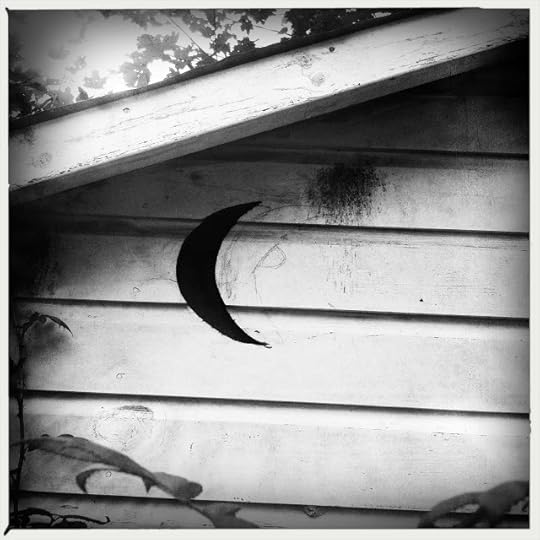 Geof Huth, "Parenthetical Shack" (for Márton Koppány) (24 September 2011)
Geof Huth, "Parenthetical Shack" (for Márton Koppány) (24 September 2011)"It has been a long hard year."
I wrote that sentence, and similar ones, on postcards I had mailed out to people a few weeks ago, postcards that were numbered 388 in my ongoing qbdp mailart series. The note was more an explanation for silence, since I had not mailed out a single qbdp card until September of this year. I assume that everyone's life, as a matter of course, is somehow difficult, and the last year has been much harder on me than on billions of others. Yet there is something about struggle, at work, at home, with one's art, that slows down a body and retards production even if the mind keeps grinding on.
And grind, it does.
It's not exactly that my productivity has retarded, though it has taken a dip since my 365 ltrs project ended on May 24th, but my productivity has been dispersed and transfigured. So I write fewer postings here and produce more photographs, which go to Tumblr or Facebook. And I'm reading less poetry, for reasons I cannot explain, so I'm writing fewer poem in my Twitter feed, but I create more audio and video poemsongs. I still write a number of poems a month, but I spend more time taking photographs that I can then call poems (and a book of these will be out in a month or so).
We grind on.
The body, it seems, produces until it stops, and even slowing is not stopping.
I was, if I remember correctly, once a photographer, in just the same way I am a visual poet. I had dozens of different cameras from the tiny negatives of a 110 camera up to a Speed Graphic that used 4" X 5" sheet film. And I used all kinds of film and played games in the darkroom. Even after developing and drying a photograph I would still change it. My photographs were simple, often without people in them, and minimalist in feel.
And now I am a photographer again, though my camera is usually my cellphone, or my phone with a little app that serves as my choice of film, camera, and darkroom games.
I am constantly looking at the world, and photographing what I can, looking for poems trapped in their native environment: reality itself.
Yesterday, I found a poem for my friend Márton Koppány, the genius Hungarian visual poet. My poem is a game itself, since it consists of my willful refusal to admit that the sign I found on shack (or, really, which my companion pointed out to me—she reduced to Edward Weston's wife and I inflated into Edward Weston himself) is actually a crescent moon, not a parenthesis, and it signifies "halfmoon," that term coming to mean "outhouse," because the shack, sitting as it does gently next to the Shushan Covered Bridge Museum in the hamlet of Shushan, New York, is really a shack designed for sitting and relief.
(Though, actually, all of that meaning is meant to resonate; I am merely pretending to direct the reader/viewer, via the device of a title, away from that fact.)
So this is a poem for Márton specifically because it is slightly reminiscent of his work, and because the cultural references might trip him up, might make this a more elusive and enigmatic poem than it would otherwise be.
Unless, of course, he reads this.
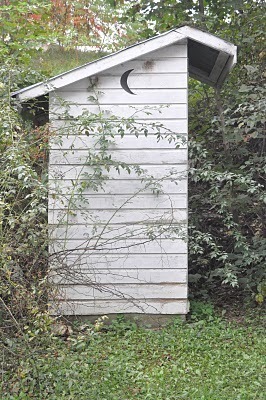 Geof Huth, "Artless Photograph of the Same Outhouse" (24 September 2011)
Geof Huth, "Artless Photograph of the Same Outhouse" (24 September 2011)ecr. l'inf.
Published on September 25, 2011 19:32
September 24, 2011
A First Reading in Another Home Country
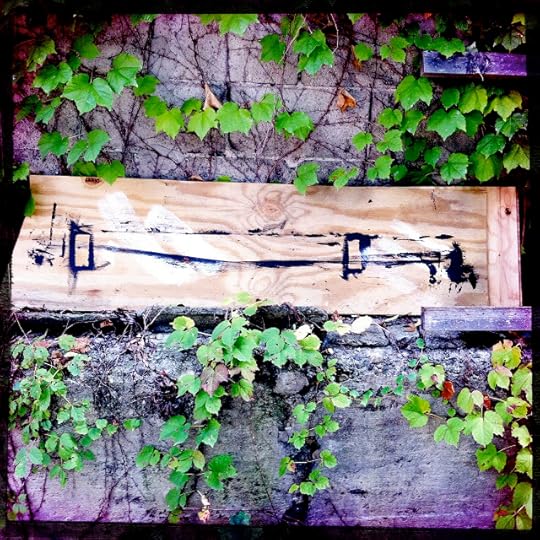 Geof Huth, "Found Asemic Poem" (17 September 2011)
Geof Huth, "Found Asemic Poem" (17 September 2011)One week from today, Nancy (AKA NF Huth) and I will be performing our poetry in St Catharine's, Ontario, along with the Ontarioan poet Angela Szczepaniak. For Nancy, this is an important reading because it will be the launch of her new chapbook "3 Words" (out from serif of nottingham editions), and because it will be the first stop on her reading tour for her new full-length book of poetry, Radiator . (Actually, it's the only stop on this book tour, so be sure to contact her to extend the tour into the future.
For me, this is an important reading because it's my first in Canada, which is one of my nine home countries, one of the nine countries where I have lived, on four different continents across the globe. This will be only the second home country I will have given a reading in (the first being the country of my birth and current residence.) As I tell my children, I consider myself part-Canadian. The country is in my blood, and my home province was Ontario, so this is a homecoming of sorts for me, though I'll be on the wrong great lake. I live on the shores of Lake Erie.
My thanks to the organizers of the Grey Borders Reading Series for setting up this event. I'll spend next Saturday driving across this state to make it to this event, to see my friend the polymath poet, Gary Barwin, and to return home for a tiny spell.
Below is my slight reworking, with links where possible, of the announcement of the reading. Be there if you can be. Note that it's not a far drive at all from Buffalo.
What?Grey Borders Reading Series' Second Event of the Season
Who?
Geof Huth (US)
NF Huth (US),
& Angela Szczepaniak (Canada)
Where?
Niagara Artists Centre (354 St. Paul Street, St. Catharines, Ontario)
When?
Saturday, October 1, 2011 @ 8pm
How?
No cover, donations encouraged.
This reading will also be the launch of NF Huth's "3 Words" published by Gary Barwin's serif of nottingham editions!
AND if that isn't enough! There is also a reception for "sicksecrets" by Laura Woermke in NAC's Members Gallery @ 7pm
Who Again?
Geof Huth's poetry consists of one-word poems, poems written in unintelligible scripts, poems painted onto canvas or assembled within boxes, poems spoken or sung and audio- or videorecorded during the moments of their creation, poems created within nature and left to disappear back into it, and even syntactic text separated into lines. He writes frequently about poetry, visual and otherwise, at his blog, dbqp: visualizing poetics. Each of his poetry performances attempts to use his entire body fully to examine the limitations of poetry. His latest book is ntst: the collected pwoermds of geof huth , a book of 775 one-word poems. His forthcoming book of poetry is AUTION CAUTION, a set of found and manipulated photopoems due out from Redfoxpress of Ireland.
NF Huth's poetry, both textual and visual, has appeared in Listenlight, The Literary Review, Philadelphia Poets, Syracuse Poems and Stories, CWM, The New Post-Literate, and others. sansound, a book of visual poetry, was published by dbqp in 2009.
In 2011 her chapbook, A Space for It , was published as part of the This is Visual Poetry series and uses photos she took in Finland, Manchester, U.K., on East Caroga Lake and in Schenectady, New York. Her first book, Radiator , has been published by Laughing/Ouch/Cube, an occasional imprint of Leafe Press, and serif of nottingham editions will publish her chapbook, 3 Words, this fall.
She publishes found sound at Click Buzz Chirp and photographic images that are both pointy and blue at Pointy Blue (both blogspot and tumblr).
NF Huth lives and writes in a strangely stone house in Schenectady, New York.
Angela Szczepaniak has conducted an enormous amount of imaginary research into the fonts of questionable usefulness that populate our most adored office suites. Her first book, Unisex Love Poems , records some of these efforts, along with some of the most ill-advised dating tips on the market. Her forthcoming book, The QWERTY Institute (annual report) is large and unwieldy, and will soon be available from BookThug (fall 2011).
And?What better way to spend a Saturday night?
ecr. l'inf.
Published on September 24, 2011 08:57
September 19, 2011
The End of the Aim of Poetry
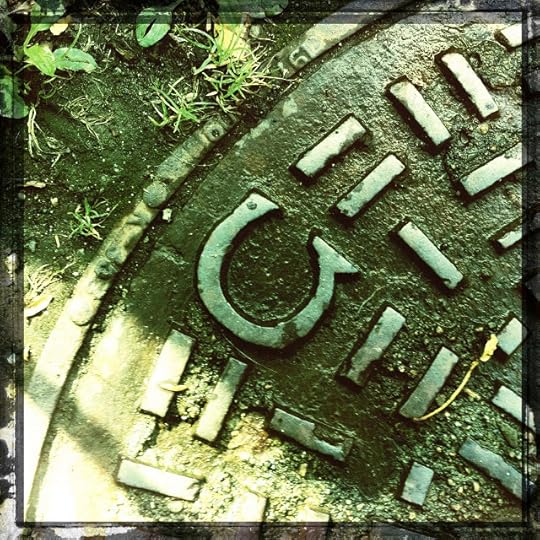 Geof Huth, "G" (18 August 2011)
Geof Huth, "G" (18 August 2011)The night has gotten away from me, as it usually does. I am gathered together in a ball of reading, on paper or screen, and small missives slip from beneath my fingers out into the world. My voice may communicate a little, but it is usually my fingers who do the work. My fingers, it seems, do the bulk of the work.
I have hands the shape of making, and so they do what bidding I might for them to do. They photograph the world as I walk through it. They capture the sound of talking as I work through it.
It is all so mysterious, this dependence on inspiration, which is simply the breathing in of the world as air and the exhalation of it as breath. It leaves warmer but changed. Stripped of its oxygen, it no longer supports life, but we believe so much in art, in artifice, in the freezing of existence into an immutable form (or putatively so) that we believe we can live on that product of inspiration: the poem sat down on a page, the photograph clicked as a representation and an undermining of reality, the song sung or the voice let go to make a word, or nearly so.
Just a thought. I explain it better here:
Speech to the Disassembled Masses (mp3)
Until the siren song takes me over.
What poetry is to me is something so simple as to be nothing more than nothing, so complex as to be nothing less than everything. (These are the kind of stupid things poets say, but only because it is through such words that we can get to an understanding of the misunderstanding the earth and cosmos, even all of this wide black inexhaustible existence.)
Poetry is the material of language, and so it is language as purely as it can be, so pure as to range beyond language to ur-language, to the particles of language.
If we can see the shape of the text of it, it could be a poem. You could be a poem if you could speak a word out of your mouth, if you could speak a moth out of your mouth. You could be a poem if the words you spoke were full of insistence but empty of meaning. If you play with the sound a voice can make, then you may have made a poem. If you could set a number of words together in syntactical order and hint at an unmade point, than you may be a maker of poems.
But you are probably already a poem.
Poems are probably already decorating your body.
Your breath is likely a poem.
If she leans in to breathe your breath, she is probably just listening for your poem.
When she finally sees it, she will cry, because that is what follows from laughter.
It is a sound poem, she might say.
<i>ecr. l'inf.</i>
Published on September 19, 2011 20:59
September 13, 2011
Creating and Labeling
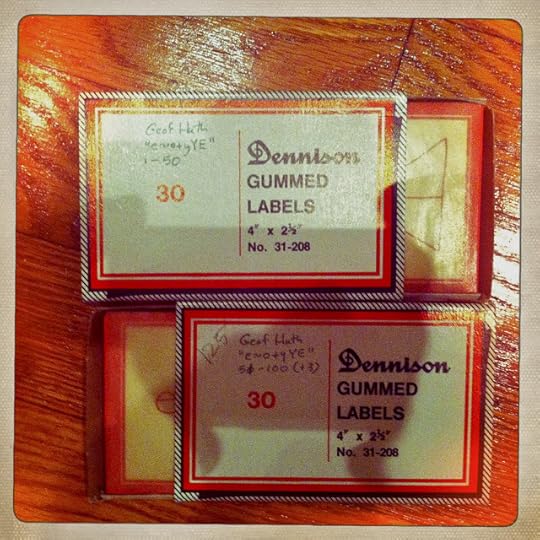
Creation is a process of repetition. At least usually. Almost nothing is created in an instant, and if it is that creation was probably preceded by repetitions that made that instant creation possible.
I have spent the last few days drawing by hand on ancient gummed labels (lick the back of one with a tongue and you can stick it anywhere). I was drawing a little fidgetglyph, a definite wrawing (half writing, half drawing), and there are many imperfections in the 103 versions I created. There is no perfection here, only a yearning for it.
Tomorrow, or maybe the next day, I will mail these to Johnny Brewton, and he will collect them together with many other sets of small things to make an issue of Bagazine, which is always filled with strange wonders and weird poetry.
As I wrote these down, as I drew each of them onto the page, I was forced to wonder what kind of poet I was, one who made drawings but said they were writing, and in this case writing about seeing, and drawings about seeing too. I was forced to think of myself as a creator of tactile poetry.
All of which made sense to me, because tactility fits into a full-body poetics.
And now it's time to rest this body.
ecr. l'inf.
Published on September 13, 2011 20:59
September 12, 2011
The Lens is an Eye
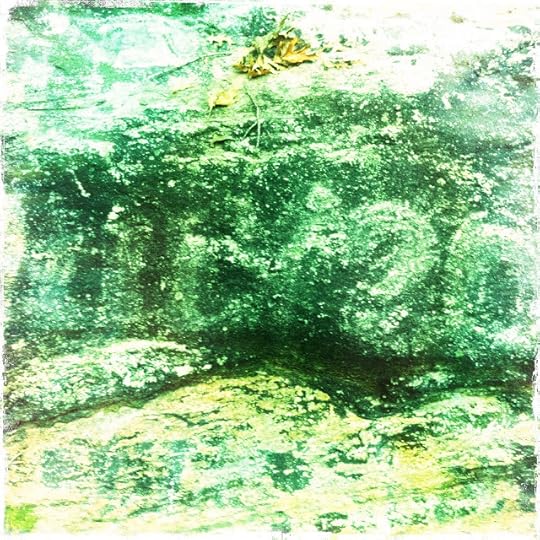 Geof Huth, "ueiso" (11 September 2011)It is difficult to tell a fact from the lie that replaced the fact. It is difficult to tell the thing from the representation of the thing. It is difficult to proceed without stumbling backwards a few steps.
Geof Huth, "ueiso" (11 September 2011)It is difficult to tell a fact from the lie that replaced the fact. It is difficult to tell the thing from the representation of the thing. It is difficult to proceed without stumbling backwards a few steps.I am a poet for the sound of the taste of the heft of the smell of the sight of the word. Poetry exists for me as an expression and discovery of language in its various forms (wraithlike in evening, bulky in the morning). Poetry is the expansion of language past the point where communication is possible to the limit where not communicating is impossible. Poetry is limitless limitations.
As I walk, I see, and I am guided by my eyes. As I walk, I extend into and through space, coming continuously out into new space, which is merely a different part of the single, continuous, and monolithic space we inhabit.
The rock is a touchstone, is the one stone of our sight and scent. Breathing it in, I can smell the lichen in its yellow-green, I can smell its dankness as well as I can smell the dryness of brown leaf. A flick of the tongue and I could taste it as a scent strengthened by firmer contact.
In a way, the poem exist for me to find it. In a way, my finding is the editing of space into the shape of a poem. In a way, my cropping of the found object of word and the means by which my method of capture transmogrifies the poem, makes the poem the poem.
That we cannot make direct sense out of the language of the poem, that the reader is asked to accept my transcription of the poem as the title of the poem, that the poem lies in place for anyone to see, if only they had the eyes for it and the yes for it, only proves the poem is exactly itself: a poem.
<i>ecr. l'inf.</i>
Published on September 12, 2011 20:59
September 11, 2011
The Tenth Anniversary of the Eleventh Day of the Ninth Month
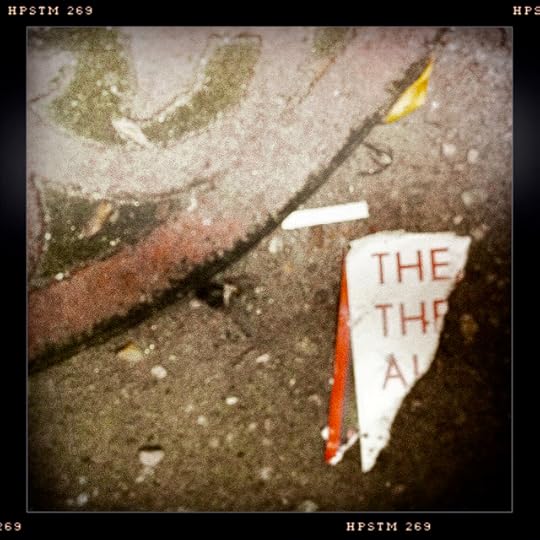 Geof Huth, "THE THE AL[L]" (11 September 2011)I'm on a train pulling out of New York City's Penn Stationas I write these words. There is no particular import to that act, yet Idecided to come to New York City late last week because I decided it was necessaryfor me to be in the city for the anniversary of the attacks on the World TradeCenter, though I realize there was loss of life elsewhere on the easternseaboard. Still, the twin tower resonate most. It was their destruction thatwas televised live. Even watching this on a blurry television at work providedme a near-simultaneous view of the destruction.
Geof Huth, "THE THE AL[L]" (11 September 2011)I'm on a train pulling out of New York City's Penn Stationas I write these words. There is no particular import to that act, yet Idecided to come to New York City late last week because I decided it was necessaryfor me to be in the city for the anniversary of the attacks on the World TradeCenter, though I realize there was loss of life elsewhere on the easternseaboard. Still, the twin tower resonate most. It was their destruction thatwas televised live. Even watching this on a blurry television at work providedme a near-simultaneous view of the destruction.I did nothing to mark the day today, spent many of my wakinghours designing and duplicating a fidgetglyph, a process that is tedious butinstructive. There is no way, I am reminded, to make the same thing twice. Eachof the fidgetglyphs is a unique instance of wrawing into existence some thing,each glyph is its own complete and separate self.
As I write these words, I realize I have no way of making aconnection between the events of September 11th, 2001, and art, atleast not my art. Some art takes those attacks and their aftermath asinspiration, and visual poetry could do the same, but it's rare. I have noexamples to give.
And I've already given, this year, my words remembering theevents of that day. At a conference, I gave a plenary talk about the New YorkState Archives' responses to that event. It was, after all, an historic event.My talk was somber, maybe poetic from time to time. During it, I made connectionsbetween the event itself and the records that helped to record it. I put therecords in context. I showed something about the value of records to help us remember.A record might be permanent, but a person never is. (I recorded this talk ofmine, which I could synchronize with the photographs and other images Iprojected for that talk, but I've never released any of these into the widerworld.)
Tonight, I don't have those memories to give. Neither do Ihave memories of the records to provide. Instead, I look back at the last tenyears of our history, and I have to conclude that the terrorist attacks on theUnited States were more successful than we usually admit.
Our world was changed because of those attacks. Our countrywas weakened, politically, financially, culturally, in terms of its prestige.All of this happened because we were afraid, and our fear allowed thegovernment of George W. Bush to do whatever he wanted to do. A land war inAfghanistan that everyone knew could not be won. A war in Iraq that many peoplerealized was unjustified. (As I said from the beginning: We knew Iraq didn'thave weapons of mass destruction because our country doesn't attack countrieswith weapons of mass destruction, especially not with ground troops.)
And we gave away our freedoms because of our fear. Even atthe time, I told people not to be afraid. I wasn't, but I probably don't fearthings as much as I should. On September 12th, 2001, I asked mysecretary to make me a plane reservation to Richmond, Virginia. She asked me ifI really wanted to, if I weren't actually too afraid to fly. I said, No. Isaid, This will be the safest time ever to fly. But it became too safe. For thenext two years, I was frequently pulled aside for further inspection throughairport security, possibly because my bearded self seemed somehow Arab orMuslim to those doing the security screening. I now have to carefully measurethe liquids and creams I bring with me, all to avoid the infinitesimal chanceof terrorism by onboard liquids.
We are now a culture of fear. And some twisted belief inpatriotism brought us to this point. It is better to die fearlessly than to livein fear, but it is easier to live in fear, so we do it, day by day, shrinkingthe size of our collected conscience and culture and principles as we do.
I have ended each of my postings on this blog with theabbreviated phrase "ecr. l'inf.," which stands for "ecrasons l'infame," whichmeans "let us crush the infamy." I added these words because I was living inthe age of George W. Bush when I started this blog, but I've never removed thisending line because the age of George W. Bush may go on forever.
<i>ecr. l'inf.</i>
Published on September 11, 2011 20:59
September 9, 2011
Helvetica, Helvetica, Why Hast Thou Forsaken Me?
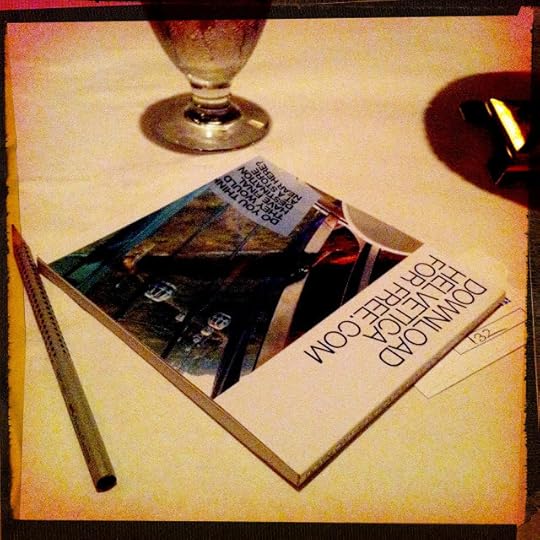
La Quinta Inn, Room 132, Williamsville, New York
Last night, I read Steve Roggenbuck's book Download Helvetica for Free.com while eating dinner at Protocol in Williamsville, New York. The waiter who served me was a web designer and aficionado of Helvetica, so we discussed design, typefaces, and poetry as the meal progressed. It was an enjoyable conversation broken into little bits.
Just as Steve's book is. At their core, the poems therein are nothing more than MSN messenger messages between Steve and his girlfriend from the end of high school into the beginning of college. The messages are short, occasionally graced by the orthographic features of such messages (spelling errors, limited punctuation) and always suffused with the rhetoric of such communications. Some are love notes, some are questions, many are essentially about their interaction with the pop culture they live within. And they are funny. And even touching. They are, after all, touched by the naiveté of youth. I enjoyed the read and finished this short book of poetry and another almost equally short one during the course of the meal.
Steve considers these works poems, and I think that he should. They use language in interesting ways, they challenge the reader to make esthetic sense of them, they are both a celebration of the contemporary world they mirror and a gentle poking as the soft and giving underbelly of that huge and almost rotting beast that surrounds us. And they require a deep understanding of that culture. In a generation, many of these poems will not be comprehensible without the apparatus of scholarship (for example, MySpace exists in these poems as a site people frequently interact with), and I wondered for a second whether that made them less good, whether universality was really a requirement of poetry, of any art. I came to no conclusions, but I'm hoping it is not. Poetry needs to do everything, so I don't want that limitation.
The entire central text of the book is set in upper case bold Helvetica, which makes sense given that that makes the poems stentorian statements of intent and revelation, little directives to us. But I did miss the beautiful order and lovely features of the lower case characters of the typeface. (Of course, the book does include, in its end matter, instructions on how to download Helvetica for free.)
This typographical decision also makes each poem a tiny poster, a little poem visualized in a certain way to gain its effects, to make its point. So these live at the cusp of visual poetry, in a little world I call visualized poetry. And, if you don't want to spend the $10 to buy the book, Steve has set it online for you to read. He, as Jack Spicer before him (though their similarities are otherwise not great), claims no copyright of these poems and encourages you to play with them to create something else.
Soon, I'll write about Steve's performance with me at the Red Rover Reading Series in Chicago, examining how these heavy-set poems function with a living voice and as a part of a full-body poetics.
_____
Roggenbuck, Steve. Download Helvetica for Free.com. Privately printed: Chicago, 2011.
ecr. l'inf.
Published on September 09, 2011 06:15
September 7, 2011
Full-Body Poetics
On the 26th of August 2011, as part of Experiment #49: Full-Body Poetics in the Read Rover Reading Series in Chicago, Illinois, Geof Huth gives a poetry performance that includes whistling, pwoermds, found poems, visual poems, lineated poems (primarily in Spanish), poems created during the performance, singing, and acrobat singing, along with a few other performative acts. Introducing Geof is Jennifer Karmin, one of the curators of the Red Rover Reading Series. Videography by Veronica Lucuy Alandia.
Over time, I've moved away from the idea of the poetry reading. It is not that I don't read poems of mine aloud for people so that they can hear them; it is merely that that is only part of what I do, and a shrinking part. I want the poem to be of the body, of the moment, so the poetry I perform I often create in situ, by speaking it out of my body, by suddenly singing it, by inviting ways to read unreadable visual poems.
So my performances, though rigidly orchestrated, are filled with extemporaneous actions, motions and words that I invent on the spot. Because every poem is extemporaneous at the point of birth, and I want to experience the birth more than I want to experience the growth into adulthood.
Above you can find a longish poetry performance of mine, complete with every kind of action and poetry I've ever put in such a performance. I won't have many places where I can the space and opportunities offered me by Jen Karmin and Laura Goldstein in the space where they hold their Red Rover Reading Series, so I appreciated this chance. And I appreciated my friend Veronica Lucuy Alandia's making the effort to videorecord this performance for me, and I appreciated the audience (which wasn't large, but size doesn't matter to me; the act matters). And I especially appreciated the smiles of the audience.
It was a good night, and I've been slow to write anything about it, and soon I'll have to write something about Steve Roggenbuck's performance, which preceded mine, but seemed to me another example of full-body poetics.
ecr. l'inf.
Published on September 07, 2011 21:19
September 2, 2011
An Ending to a "Reading"
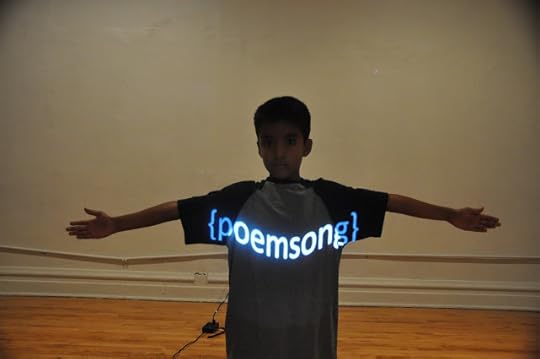 Diego as poemsong (Chicago, Illinois, 26 August 2011)A week ago Friday, I gave a poetry performance in Chicago. (I've dispensed with the term "poetry reading," since I read, recite, sing, invent on the spot, dance, scream, pace, talk, and whistle.) I was one of a couple of performers, the other being Steve Roggenbuck, who read, but also sang and danced. Ours was "Experiment # 49: Full-Body Poetics" in the the Red Rover Reading series. The audience was small (some being no more than three feet tall) yet not tiny. And it was a good experience, one I would have written about by now if I hadn't been focused on rescheduling my flight out of Chicago, which was cancelled because of Hurricane Irene and if my return to New York didn't focus me on overseeing providing assistance to government agencies dealing with, by far, the largest numbers of records disasters, some huge, that I've seen in two decades of doing this work. And maybe I would have done something sooner if the video of my performance was viewable on anything besides the handheld device that captured it, because any downloaded copy of the show plays, but only with loud static throughout.
Diego as poemsong (Chicago, Illinois, 26 August 2011)A week ago Friday, I gave a poetry performance in Chicago. (I've dispensed with the term "poetry reading," since I read, recite, sing, invent on the spot, dance, scream, pace, talk, and whistle.) I was one of a couple of performers, the other being Steve Roggenbuck, who read, but also sang and danced. Ours was "Experiment # 49: Full-Body Poetics" in the the Red Rover Reading series. The audience was small (some being no more than three feet tall) yet not tiny. And it was a good experience, one I would have written about by now if I hadn't been focused on rescheduling my flight out of Chicago, which was cancelled because of Hurricane Irene and if my return to New York didn't focus me on overseeing providing assistance to government agencies dealing with, by far, the largest numbers of records disasters, some huge, that I've seen in two decades of doing this work. And maybe I would have done something sooner if the video of my performance was viewable on anything besides the handheld device that captured it, because any downloaded copy of the show plays, but only with loud static throughout.So, tonight, I'll remember two things from this performance. The first is Diego, and the second is his father Carlos, both of whom came to my performance with my friend, the Bolivian poet Veronica Lucuy Alandia, who did a great job capturing video of my performance, even though the machine decided to mangle the audio a bit. What I remember from the show is that Diego moved to the front row so he could see me better, that he sat there watching me with a huge smile on his face, and that he played with the projected final slide of the visual part of my show and, in doing so, made himself into a poemsong. And I remember that his father Carlos, also from Bolivia as was his wife Veronica, changed his own son Diego into a poemson.
And, together, those were the best results I'd ever indirectly engendered from a performance of mine. As Jen Besemer so poetically said, at the end of a little written recollection of that night, "we are phrase and phoneme and pixel and pigment."
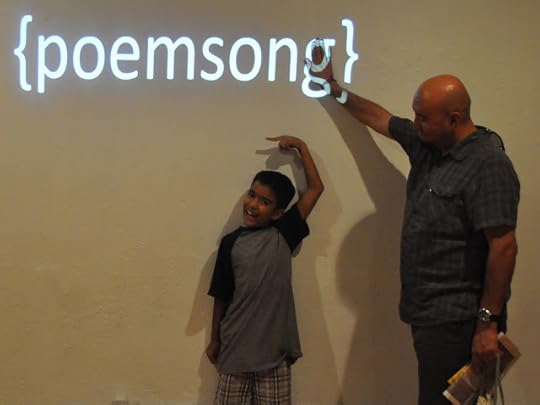 Diego as Carlos' poemson (Chicago, Illinois, 26 August 2011)<i>ecr. l'inf.</i>
Diego as Carlos' poemson (Chicago, Illinois, 26 August 2011)<i>ecr. l'inf.</i>
Published on September 02, 2011 21:55
August 26, 2011
In Place of Placing
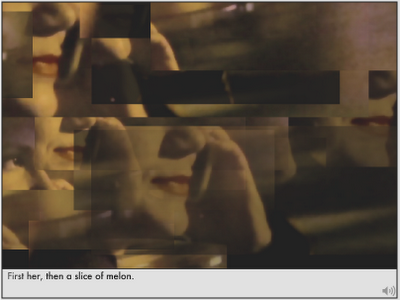
Hotel 71, Room 2812, Chicago, Illinois
I am in Chicago for the annual meeting of the Society of American Archivists. This year is the 75th anniversary of the association, so the celebrations are a little more enhanced than in the past. Still, I will be missing the giant all-attendees reception tonight because I'll be giving a poetry performance ("reading" doesn't seem to be the right term for what I do) with Steve Roggenbuck as part of the Red Rover reading series. Our joint performances will constitute Red Rover Experiment # 49: Full-Body Poetics, and I'll try to live up to that title even though I'll be working with a back I twisted out of whack by gently rotating my torso while in the opening plenary session yesterday morning.
A hurricane by the name of Irene is moving in a continuing gyre up the east coast at the moment, one of apparently some significance, though my connection to current events has been diminished since my arrival in Chicago. I have been meeting with poets, archivists, and college friends (with more to come), and I've been talking too much, performing with my voice (which seems at least part of the charge of the poet), and proving the extent of the inappropriateness of my near-constant humor.
Although my airlines will allow me to change my flight for free to avoid the onslaught of Irene, and even though the hurricane seems intent on affecting Albany, New York, which is my eventual destination, Albany is not on their list, so I will be staying in Chicago until my flight takes off at around 7:00 pm on Sunday evening, if it leaves at all.
While I've been in Chicago (though, truthfully, even before that), I've not posted to this site because my busyness and late nights have kept me from finding the time for even a few words. But I slept in this morning to prepare myself for the reading tonight, so I've taking some time to write these words.
Also, I have a little digital poem to point people to. It uses lines from my long poem in continuing progress, One Million Footnotes, as well as the work of many other people.
Entitled "Notes Noir," its credits are as follows: concept and roadwork by runran, visualization and code by crissxross, based loosely on animations by babel, photograph of Ailsa Dyson by Gordie Agar (Winnipeg), texts adapted from One Million Footnotes by poet Geof Huth, and music loop from "Palais de Glace" by media artist Talan Memmott. It's a beautiful haunting little accumulation of esthetic inputs, and my text even adds to, rather than detracts from, the whole. It's worth at least a couple of minutes of contemplation. It even requires it of the reader/listener/viewer.
ecr. l'inf.
Published on August 26, 2011 08:24



